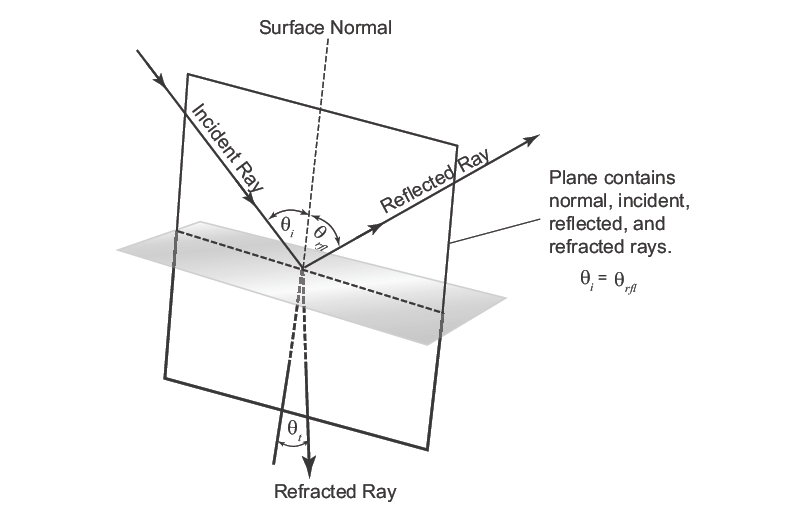Optical Mirror Physics
Optical Mirror Physics
Optical Mirror Physics
Reflection


Mirrors made up of planar surfaces, such as that shown in Figure 1, are important components for directing light through the proper path in an optical system. Such mirrors can be combined to form optical components known as retroreflectors or corner cubes. These components consist of three mirror surfaces all perpendicular to one another. Such a geometry enables 180 degrees reflection of the light, regardless of incidence angle, and therefore requires very little alignment compared to a single flat mirror. In addition to stationary mirrors, rapid redirection can be achieved by utilizing rotating planar mirror systems such as those found in scanners or on a smaller scale with micromirrors, which are used for switching in telecommunications and displays. Curved mirror surfaces (also called concave reflectors) can be exploited with the goal of collecting, focusing, and imaging light as illustrated in Figure 2. These mirrors possess an advantage over lenses (see Optical Lens Physics) in that they perform satisfactorily across a broad-wavelength range without requiring refocusing. The reason for this is that reflection occurs at the surface of these optics, rather than passing through the optic as is the case with a lens, and so the dispersion of the index of refraction does not come into play. Simple spherical reflectors can be used to collect radiation from a source at the focal point (located at half of the radius of curvature of the mirror) and reflect it as a collimated beam parallel to the axis. Since spherical mirrors possess spherical aberration (see Section III.A.3), a parabolic curved surface can be used instead to either collimate light from a focal point or focus light from a collimated beam (see Figure 2). Ellipsoidal surfaces can focus light from one focal point to another (see Figure 2).

Mirror Characteristics

Prior to depositing the optical coating, the substrate’s surface must be ground and polished to the proper shape (either planar or curved). The surface quality and flatness determine the fidelity of the mirror performance with the targeted application dictating the requirements for these parameters. Surface flatness is often specified in wavelengths, e.g. λ/10, over the entire usable area of the mirror. When preservation of the wavefront is critical, a λ/10 to λ/20 mirror should be selected, while less demanding applications can tolerate a λ/2 to λ/5 mirror with the associated reduction in cost. Surface quality is usually dictated by the severity of random localized defects on the surface. These are often quantified in terms of a “scratch and dig” specification, e.g. 20-10, with a lower value indicating improved quality and therefore lower scattering. For high precision surfaces, such as those found within the cavity of a laser, a scratch-dig specification of 10-5 may be required since it would yield very little scattered light. Surface polishing tolerances in terms of irregularity, surface roughness, and cosmetic imperfections are verified using state-of-the-art metrology equipment. These same parameters and procedures are used to assess the quality and flatness of other optical components such as lenses or windows.
Related Topics
Optical Components
- Optical Lens Physics
- Diffraction Grating Physics
- Optical Coatings
- Optical Filters
- Polarization Optics
Optical Systems